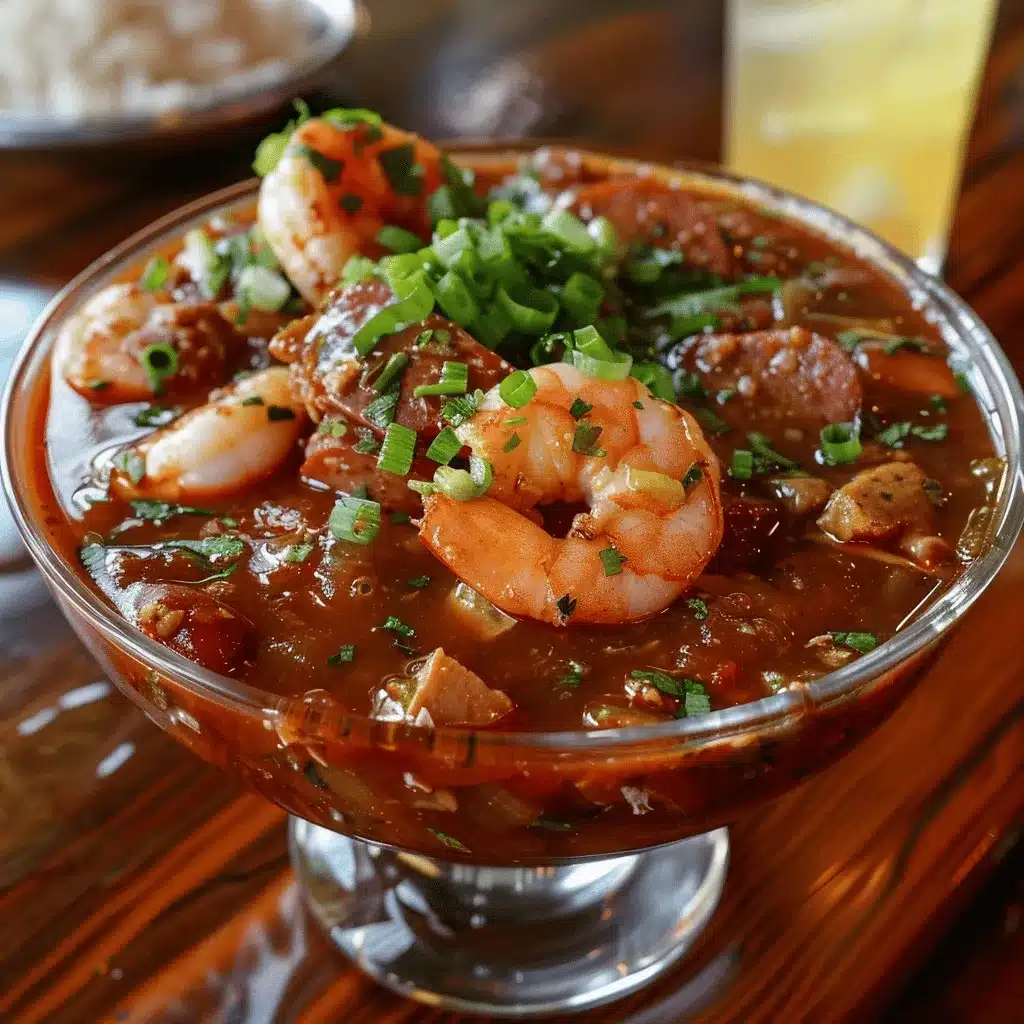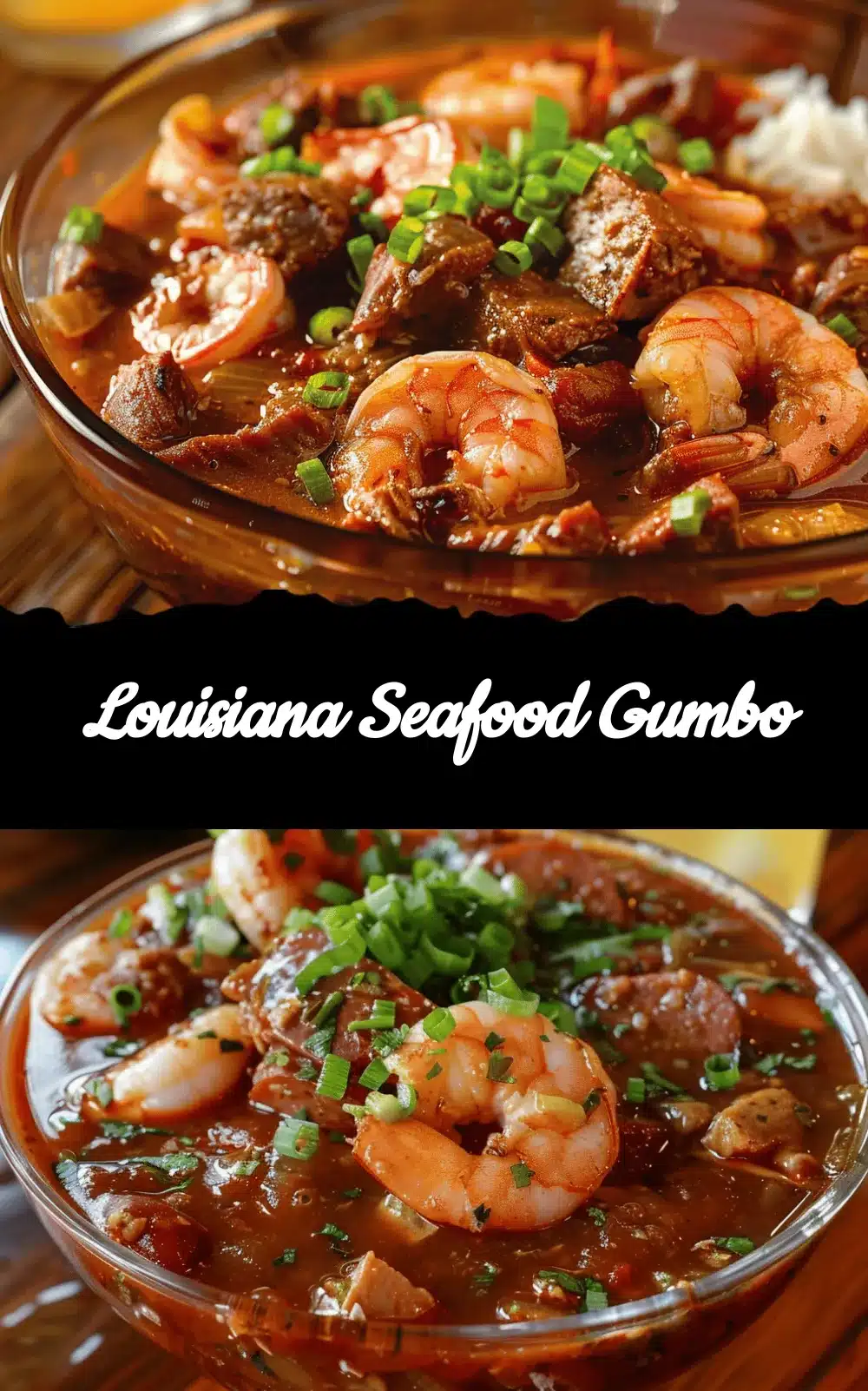The first time I made a big pot of Louisiana seafood gumbo, the whole house filled with a buttery, spicy aroma that just clung to your skin—honestly, it felt like Mardi Gras came to my kitchen. There’s nothing quite like the slow simmer of gumbo bubbling on the stove, packed with plump shrimp, sweet crab, and that deep, smoky flavor from the roux. My gumbo journey started during a family trip to New Orleans, where I tasted the real deal for the first time; since then, I’ve chased that perfect bowl, making tweaks and learning secrets from Southern friends along the way.
Louisiana seafood gumbo isn’t just another soup—it’s a celebration. You feel the soul of the South in every spoonful. Whether you’re making it for a cozy Sunday dinner, cooking for a crowd, or just craving a taste of the bayou, this gumbo brings people together. It’s loaded with fresh seafood, hearty and deeply flavorful, but it’s also surprisingly approachable for home cooks. If you’ve ever worried gumbo would be too complicated—don’t! After making this recipe more times than I can count (with a few kitchen messes and happy accidents thrown in), I’ve learned a few tricks that guarantee success every time.
I keep coming back to this Louisiana seafood gumbo recipe because it’s pure comfort food with a Southern soul. There’s something magical about serving a big bowl to friends and watching their eyes light up. If you’re looking for a dish that’s rich, a little spicy, and completely satisfying, you’re in the right place—this gumbo is for families, seafood lovers, and anyone who wants to cook up a taste of Louisiana in their own kitchen. Let’s get started!
Why You’ll Love This Louisiana Seafood Gumbo Recipe
- Big, Bold Flavors: Each bite is packed with layers—smoky roux, briny seafood, a gentle kick from Cajun spices, and the sweetness of the “holy trinity” veggies.
- Traditional, Yet Flexible: While this gumbo stays true to its Louisiana roots, it’s easy to swap in your favorite seafood or adjust the heat.
- Restaurant Quality at Home: After years of testing, I promise this recipe rivals the best gumbo I’ve eaten in New Orleans.
- Feeds a Crowd: This recipe makes enough for a hungry family (with leftovers that taste even better the next day).
- No Special Skills Needed: If you can stir, you can make Louisiana seafood gumbo! I’ll walk you through the roux—no stress, just good eating.
This isn’t just any seafood gumbo—it’s my go-to for chilly nights, game day gatherings, or when I want to treat myself. The deep, dark roux gives the broth a nutty backbone you can’t fake. The combination of shrimp, crab, and sometimes oysters or crawfish, makes every bowl a little treasure hunt. It’s a dish that brings people to the table—honestly, my kids (who can be picky) ask for seconds without fail.
What really sets this Louisiana seafood gumbo apart is the attention to detail: slowly browning the roux, building flavor with homemade stock, and using the freshest seafood you can find. Even if you’re new to Southern cooking, you’ll feel like a gumbo pro after making this recipe. It’s soul food at its best—hearty, nostalgic, and guaranteed to impress. Go ahead, ladle up a big bowl and see why this gumbo is a Southern favorite!
Ingredients Needed for Louisiana Seafood Gumbo
This recipe uses classic, flavorful ingredients you can find in most grocery stores. If you ever wondered what goes into an authentic Louisiana seafood gumbo, here’s the rundown. These staples come together for a rich, soulful stew with just the right kick.
- For the Roux:
- 1 cup (120g) all-purpose flour
- 1 cup (240ml) vegetable oil (can substitute with canola or peanut oil)
- The “Holy Trinity” (Vegetables):
- 1 large yellow onion, finely chopped
- 1 large green bell pepper, chopped
- 2 celery stalks, chopped
- Additional Vegetables & Aromatics:
- 4 cloves garlic, minced
- 2 bay leaves
- 3 green onions, sliced
- 1/4 cup (15g) fresh parsley, chopped
- Seafood:
- 1 pound (450g) large raw shrimp, peeled and deveined (leave tails on for flavor, optional)
- 1 pound (450g) crabmeat (lump or claw is fine—pick through for shells)
- 1/2 pound (225g) shucked oysters, drained (optional, but traditional)
- 1/2 pound (225g) andouille sausage, sliced (adds smoky depth; use turkey sausage for lighter version)
- Liquids & Seasonings:
- 6 cups (1.4L) seafood stock or chicken stock (homemade or low-sodium store-bought)
- 1 (14.5 oz / 411g) can diced tomatoes (with juice)
- 2 tsp Cajun seasoning (adjust to taste; I like Tony Chachere’s or Slap Ya Mama)
- 1 tsp smoked paprika
- 1/2 tsp dried thyme
- 1/2 tsp black pepper
- 1/2 tsp salt (to taste)
- 1/4 tsp cayenne pepper (for extra heat; optional)
- 1 tbsp Worcestershire sauce
- 1 tsp hot sauce (like Crystal or Tabasco; optional)
- For Serving:
- Cooked white rice (jasmine or long grain; about 1 cup/200g per serving)
- More chopped parsley and sliced green onions
- Filé powder (ground sassafras, optional but classic for thickening and flavor)
Ingredient Notes & Substitutions: For gluten-free gumbo, use a gluten-free flour blend for the roux. Can’t find fresh crab? Use good-quality canned lump crab. Want a lighter gumbo? Swap andouille for chicken sausage. For a pescatarian version, skip the sausage altogether. Feel free to add crawfish if you have them—so good in season!
Equipment Needed for Homemade Seafood Gumbo
- Large Dutch Oven or Heavy-Bottomed Pot: Essential for even heat and the long simmer. I’ve tried using a stockpot, but a Dutch oven really holds heat best.
- Wooden Spoon or Heatproof Spatula: For stirring the roux—trust me, don’t use plastic here.
- Sharp Chef’s Knife: For chopping onions, peppers, and celery.
- Cutting Board: Preferably two—one for veggies, one for seafood.
- Measuring Cups & Spoons: For accuracy, especially with the roux and seasonings.
- Ladle: Makes serving easy and mess-free.
- Medium Mixing Bowl: For prepping shrimp or crab before adding to the pot.
If you don’t own a Dutch oven, a heavy-bottomed soup pot will work. Avoid thin-bottomed pots—burnt roux is a sad day! I once tried making gumbo in an old, lightweight pot and ended up with scorched bits stuck everywhere. Lesson learned: invest in a good, sturdy pot. For budget-friendly options, check local discount stores; I found a fantastic enameled Dutch oven on sale years ago, and it’s still going strong. Always wash your tools right after cooking—roux can get sticky if left to dry.
How to Make Louisiana Seafood Gumbo – Step-By-Step Preparation

- Prep All Ingredients: Chop onions, peppers, and celery. Mince garlic and set aside. Peel and devein shrimp (if needed). Rinse crabmeat, check for shells. Slice sausage. (Tip: prepping everything first makes gumbo smoother—mise en place is your best friend!)
- Make the Roux (about 20-25 minutes): In a large Dutch oven, combine 1 cup (120g) flour and 1 cup (240ml) oil over medium heat. Stir constantly with a wooden spoon. The roux will start pale and gradually darken—aim for a deep chocolate color. Don’t walk away! If you see black specks, start over. (Smells nutty when ready, almost like toasted pecans.)
- Add the Holy Trinity (5 minutes): Stir in onions, bell pepper, and celery. Sauté in the hot roux until softened, about 5 minutes. The mixture should be glossy and fragrant. Add garlic and cook 1 minute more.
- Build the Broth (3 minutes): Slowly pour in 6 cups (1.4L) seafood or chicken stock, stirring constantly to avoid lumps. Add diced tomatoes (with juice). Toss in bay leaves, thyme, smoked paprika, Cajun seasoning, salt, pepper, cayenne, and Worcestershire sauce. Stir well. (If your pot is crowded, move slowly to avoid splashing.)
- Simmer the Gumbo (30-40 minutes): Bring to a gentle boil, then reduce to a simmer. Add sliced andouille sausage. Let it simmer, uncovered, for 30-40 minutes, stirring occasionally. The gumbo should thicken and the flavors deepen. (If it seems too thick, add a bit more stock or water.)
- Add the Seafood (5-8 minutes): Stir in shrimp, crabmeat, and oysters (if using). Simmer gently for 5-8 minutes, just until shrimp turn pink and opaque. Don’t overcook—seafood can get rubbery. Taste and adjust salt or hot sauce as desired.
- Finish & Serve: Turn off the heat. Stir in parsley and green onions. Sprinkle with filé powder if using (about 1/2 teaspoon per bowl). Serve over hot cooked rice, garnish with extra parsley and green onions.
Prep Notes: If your roux gets lumpy when adding stock, whisk vigorously—it usually smooths out. If you need to hold the gumbo before serving, keep it on low and add seafood last, so it stays tender. Some like to make gumbo a day ahead; flavors meld and deepen overnight (just reheat gently!).
Cooking Tips & Techniques for Authentic Gumbo
- Patience with the Roux: Don’t rush this step. The deeper the color, the richer the flavor. I used to get impatient and stop too soon—now I know to wait for that chocolate brown, even if my arm gets tired.
- Stir, Stir, Stir: Never leave the roux unattended. Even one minute can mean burnt roux and a bitter gumbo. Keep stirring in figure-eights for even cooking.
- Stock Matters: Homemade seafood stock amps up the flavor. If you use store-bought, pick a low-sodium version and season to taste.
- Timing Seafood: Add shrimp and crab at the end—overcooked seafood gets tough. If you’re making gumbo ahead, wait to add seafood until just before serving.
- Building Layers: Sauté the vegetables until they’re really soft before adding stock. This little trick brings out extra sweetness and depth.
- Don’t Fear the Filé: Sprinkle filé powder at the end, not during cooking, to avoid stringiness. It adds authentic flavor and thickens the gumbo just right.
- Consistency: Gumbo should coat the back of a spoon, not be watery like soup. If it’s too thin, simmer uncovered. If too thick, splash in more stock.
One time, I rushed the roux and regretted it—trust me, it makes all the difference. Another trick: multitask by chopping veggies while the roux cooks (just don’t get distracted!). Gumbo is forgiving if you keep tasting and adjusting along the way. And if you ever feel overwhelmed, just remember—every batch gets better with practice.
Variations & Adaptations for Louisiana Seafood Gumbo
- Gluten-Free Gumbo: Use a 1:1 gluten-free flour blend for the roux. I’ve tried this with King Arthur’s blend, and it worked beautifully—no one noticed the swap.
- Low-Carb Version: Skip the rice and serve over cauliflower rice. You can also use turkey sausage for a lighter, lower-fat gumbo.
- Seasonal Additions: Add okra (sliced, about 2 cups/200g) in summer for extra thickness and that classic flavor. In winter, toss in a handful of cooked crawfish tails.
- Dairy-Free & Pescatarian: Omit sausage for a seafood-only gumbo. It’s still rich and satisfying. Use a touch more smoked paprika for depth.
- Spice Level: For mild gumbo, use less cayenne and a gentle Cajun seasoning. For a fiery version, double the hot sauce and add extra jalapeño.
I once tried a gumbo with smoked turkey legs instead of sausage, and it brought a whole new savory note—great for Thanksgiving leftovers! If you have seafood allergies, substitute with chicken thighs (diced) and use chicken stock. Gumbo is about making do with what you’ve got—don’t be afraid to get creative.
Serving & Storage Suggestions
Louisiana seafood gumbo is best served piping hot over fluffy white rice. I love to use deep bowls and pile the gumbo high, then sprinkle with extra green onions and parsley. For special occasions, serve with warm French bread or cornbread—perfect for soaking up every drop.
Pair gumbo with a crisp salad or classic Southern sides like coleslaw, fried okra, or hushpuppies. I’m partial to an ice-cold glass of sweet tea or a local Louisiana beer to balance the spice.
For leftovers, let gumbo cool to room temperature, then store in airtight containers in the refrigerator for up to 3 days. Gumbo flavor deepens overnight (honestly, it’s even better the next day). To freeze, portion into freezer-safe containers for up to 2 months. Thaw in the fridge overnight, then reheat gently on the stovetop over low heat, stirring occasionally. If gumbo thickens too much, add a splash of stock or water. Rice is best cooked fresh, but you can store it separately in the fridge for up to 3 days.
Nutritional Information & Benefits
This Louisiana seafood gumbo recipe is hearty yet surprisingly balanced. Each serving (about 2 cups gumbo with 1/2 cup rice) contains roughly:
- Calories: 380
- Protein: 22g
- Fat: 15g
- Carbohydrates: 38g
- Sodium: 900mg (varies with stock and sausage)
Seafood is a powerhouse—shrimp and crab provide lean protein, omega-3s, and minerals. The “holy trinity” veggies offer vitamins and fiber. If you use brown rice or serve over cauliflower rice, you boost nutrition even more. This gumbo is naturally dairy-free, and with the right flour, can be gluten-free. It does contain shellfish and possibly wheat (roux)—always check for allergies. Personally, I love this dish as a lighter, feel-good comfort food—especially after a long week!
Conclusion
There’s a reason Louisiana seafood gumbo is a Southern classic—it’s soulful, satisfying, and always brings people together. Whether you’re a gumbo newbie or a seasoned cook, this recipe delivers deep flavor and loads of comfort right in your own kitchen. It’s perfect for family dinners, festive gatherings, or just when you need a taste of the bayou.
Don’t be afraid to put your own spin on it—add your favorite seafood, play with the spice, or try a new veggie. That’s what gumbo is all about! Personally, this gumbo is close to my heart; every batch brings back memories of family, laughter, and the warm hospitality of the South.
If you try this recipe, I’d love to hear how it turned out! Drop a comment below, share your gumbo creations on Pinterest, or let me know any twists you added. Remember, the best gumbo is the one made with love—happy cooking, y’all!
Frequently Asked Questions about Louisiana Seafood Gumbo
What’s the secret to a flavorful roux?
The key is patience! Cook the flour and oil over medium heat, stirring constantly until it turns a deep chocolate brown. Don’t rush—let it get nice and dark for maximum flavor.
Can I use frozen seafood for gumbo?
Absolutely. Just thaw it completely and pat dry before adding to the pot. Fresh is best, but good-quality frozen shrimp and crab work great in a pinch.
Is gumbo spicy?
It can be! This Louisiana seafood gumbo has a gentle kick, but you can adjust the cayenne and hot sauce to fit your taste. Start mild, then add more heat at the end if you like.
How do I thicken gumbo without filé powder?
You can add sliced okra during simmering—it naturally thickens the gumbo. If you skip both, just reduce the gumbo a bit longer on the stove for a thicker consistency.
Can I make gumbo ahead of time?
Definitely. In fact, gumbo tastes even better the next day as the flavors meld. Store in the fridge and add seafood just before serving if possible for the best texture.
Pin This Recipe!


Louisiana Seafood Gumbo
- Total Time: 1 hour 15 minutes
- Yield: 6 servings 1x
Description
This easy homemade Louisiana seafood gumbo is a Southern favorite, packed with shrimp, crab, and andouille sausage in a rich, smoky roux-based broth. Perfect for family gatherings or cozy nights, it brings the soul of the bayou to your kitchen.
Ingredients
- 1 cup all-purpose flour
- 1 cup vegetable oil (can substitute with canola or peanut oil)
- 1 large yellow onion, finely chopped
- 1 large green bell pepper, chopped
- 2 celery stalks, chopped
- 4 cloves garlic, minced
- 2 bay leaves
- 3 green onions, sliced
- 1/4 cup fresh parsley, chopped
- 1 pound large raw shrimp, peeled and deveined (tails on optional)
- 1 pound crabmeat (lump or claw, picked through for shells)
- 1/2 pound shucked oysters, drained (optional)
- 1/2 pound andouille sausage, sliced (or turkey sausage for lighter version)
- 6 cups seafood stock or chicken stock (homemade or low-sodium store-bought)
- 1 (14.5 oz) can diced tomatoes (with juice)
- 2 teaspoons Cajun seasoning (adjust to taste)
- 1 teaspoon smoked paprika
- 1/2 teaspoon dried thyme
- 1/2 teaspoon black pepper
- 1/2 teaspoon salt (to taste)
- 1/4 teaspoon cayenne pepper (optional, for extra heat)
- 1 tablespoon Worcestershire sauce
- 1 teaspoon hot sauce (like Crystal or Tabasco, optional)
- Cooked white rice (about 1 cup per serving)
- More chopped parsley and sliced green onions for garnish
- Filé powder (optional, for serving)
Instructions
- Prep all ingredients: Chop onions, peppers, celery, and mince garlic. Peel and devein shrimp, rinse crabmeat, and slice sausage.
- Make the roux: In a large Dutch oven, combine flour and oil over medium heat. Stir constantly with a wooden spoon for 20-25 minutes until the roux is a deep chocolate brown. Do not walk away; if black specks appear, start over.
- Add the holy trinity: Stir in onions, bell pepper, and celery. Sauté in the hot roux until softened, about 5 minutes. Add garlic and cook 1 minute more.
- Build the broth: Slowly pour in seafood or chicken stock, stirring constantly to avoid lumps. Add diced tomatoes with juice, bay leaves, thyme, smoked paprika, Cajun seasoning, salt, pepper, cayenne, and Worcestershire sauce. Stir well.
- Simmer the gumbo: Bring to a gentle boil, then reduce to a simmer. Add sliced andouille sausage. Simmer uncovered for 30-40 minutes, stirring occasionally. Add more stock or water if too thick.
- Add the seafood: Stir in shrimp, crabmeat, and oysters (if using). Simmer gently for 5-8 minutes, just until shrimp turn pink and opaque. Do not overcook.
- Finish and serve: Turn off the heat. Stir in parsley and green onions. Sprinkle with filé powder if using. Serve over hot cooked rice and garnish with extra parsley and green onions.
Notes
For gluten-free gumbo, use a gluten-free flour blend for the roux. Add okra for extra thickness and classic flavor. Add seafood at the end to avoid overcooking. Gumbo tastes even better the next day as flavors meld. Adjust spice level to taste. Serve with French bread or cornbread for soaking up the broth.
- Prep Time: 25 minutes
- Cook Time: 50 minutes
- Category: Main Course
- Cuisine: Southern, Cajun, Creole
Nutrition
- Serving Size: About 2 cups gumbo with 1/2 cup rice
- Calories: 380
- Sugar: 6
- Sodium: 900
- Fat: 15
- Saturated Fat: 3
- Carbohydrates: 38
- Fiber: 3
- Protein: 22
Keywords: seafood gumbo, Louisiana gumbo, Cajun gumbo, Southern gumbo, shrimp gumbo, crab gumbo, andouille sausage, Mardi Gras, comfort food, easy gumbo, homemade gumbo, New Orleans gumbo










